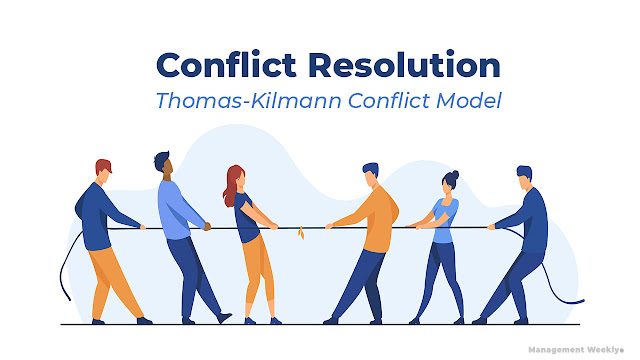Discuss the two dimensional model for conflict resolution
Talk about the two layered model for compromise
Experts Kenneth Thomas and Ralph Kilmann encouraged a model
for settling conflicts. This model is known as the Thomas-Kilmann model.
Battle occurs whenever people struggle. The contention could
be over their perceptions, contemplations, values, motivations, or needs.
This model relies upon two components of harmony advancement:
conclusiveness and sympathy.
Considering these two perspectives, there are five trade off
systems: Fighting, Avoiding, Obliging, Cooperating and Finding some middle
ground.
Examine the two layered model for
compromise
Two Components of Refereeing (Insistence and Compassion)
The essential part of refereeing is self-assuredness.
Insistence insinuates the ability to whoop and stay by your perspectives. It
will in general be used either unequivocally or antagonistically, dependent
upon its application. While conclusive approach to acting might seem, by all
accounts, to be strong, it is actually a way to deal with putting yourself out
there effectively.
ALSO READ:-
Describe Intervention To Reduce AggressionSympathy is the second component of harmony advancement. Compassion infers getting a handle on another person's viewpoint and feelings. Exactly when you comprehend someone else, you're prepared to put yourself into that other person's situation. Subsequently, you'll find approaches to resolving the dispute even more easily.
Five Trade off Frameworks: Battling, Avoiding, Obliging, Collaborating and Compromising
These five frameworks address different ways of managing
supervising battle. They all have different characteristics and inadequacies.
The best procedure depends upon the specific circumstances reachable.
1. Battling
At the upper left finish of the blueprint, we have high
certainty and low sympathy. We use battling as a trade off strategy whenever we
resort to being powerful. Additionally, we in like manner get uncooperative
with the adversary.
- The essential system for overseeing battle is fighting.
- This methodology works outstandingly when you are in a requesting position and have limited time and resources for decide the conflict.
- Battling isn't awful constantly. Taking everything into account, fighting helps us with achieving our goals.
- Talk about the two layered model for compromise
In any case, this method has a couple of weaknesses. In any
case, battling generally prompts cynical sentiments like shock, disappointment,
hostility and animosity. Second, it doesn't help you with building
extraordinary associations since you don't wait there, standing by listening to
what others say. Finally, it could achieve losing likely entryways considering
the way that the other party would prefer not to work with you any longer.
2. Avoiding
At the base left finish of the diagram, we see low
unequivocation and low empathy. That suggests you neither asset your position
nor do you consider or underline the other party's point of view.
The second method for overseeing battle incorporates avoiding
it.
People use this harmony making method when they understand
that they have no control over the other person. Taking everything into
account, they avoid a confrontation by ignoring or avoiding the conflict
completely. They moreover choose to ignore the issue completely.
Avoiding is every now and again considered inert and frail.
Regardless, if you really need to avoid a conflict, you should do thusly.
Hence, you won't have to deal with the issue, which will give
you veritable serenity.
3. Obliging
In the base right piece of the graph, we track down low
certainty and high sympathy.
Obliging is a third procedure for overseeing battle.
The idea behind this approach is to make concessions. For
example, if one individual makes a sales, you agree to do what the essential
individual referenced instead of quarreling over the matter.
Examine the two layered model for
compromise
It's a convincing strategy for managing battle when you want
power. Regardless, be mindful — by making concessions, you could start to let
totally go over your own arrangement.
So how should you tell whether giving in merits the trouble?
Make sure to weigh up the benefits and detriments before picking.
4. Joint exertion
Up above on the upper right, we see high definitiveness and
high sympathy.
Exactly when you group up, you embrace a moderate technique
to handling issues. You try to change power among yourself and another person.
You similarly endeavor to sort out some shared interest and work together
towards achieving a typical goal.
It's an ideal choice in case the two players are centered
around concurring. The goal here is to concur with each other.
Nonetheless, recall: participation isn't basic constantly. It
requires granting individual bits of knowledge and opinions. It similarly needs
two people who trust each other and regard coordinating.
5. Finding some middle ground
In the model is the fifth methodology, which is compromising.
This is the focal point of determination and empathy scales.
Examine the two layered model for
compromise
Accepting you put down some a reasonable compromise, you take
the middle road between going against sees. This suggests consenting to
unequivocal terms and forsaking explicit various things. Likewise, since you're
endeavoring to decide a contention, you truly should show flexibility.
This technique normally gives the impression of a commonly
gainful circumstance, where the two players feel that they procured something
out of the dispute.
ALSO READ:-
The Nature And Characteristics Of Attitudes








0 comments:
Note: Only a member of this blog may post a comment.